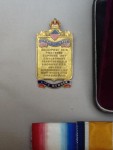CORRIGAN, Thomas Norman
Although born in East Melbourne in 1892, Thomas Norman Corrigan had little contact with the suburb. When he enlisted, aged 22, on 27 January, 1915, he was living at 25 Ford St., Brunswick and working as a tea packer. He joined the 21st Battalion, raised at Broadmeadows in early February, 1915, and drawn from all over Victoria. They embarked from Melbourne on HMAT Ulysses A38 on 10 May, 1915, arriving in Egypt in June.
From here, they proceeded to Gallipoli in late August, 1915. The 21st Battalion's transport vessel, HMT Southland, was torpedoed near Lemnos on 2 September and had to be abandoned. Tom's paybook, however, was picked out of the water afer the torpedoeing and was on display at the Australian War Memorial, Canberra, for many years afterthe war. The 21st Battalion finally landed at Anzac Cove on 7 September. Here on 7 November, 1915, Tom Corrigan was wounded in the shoulder from a shell, but the wound was not life threatening. He was evacuated to Lemnos and then admitted to the No. 1 Auxiliary Hospital at Heliopolis and spent 33 days recovering before being sent back to Cairo. He left hospital on 7 December and rejoined the battalion in Egypt in January, following their evacuation from Gallipoli in December. From Egypt, they moved to France, the 21st Battalion, arriving in March 1916.
On 24 February, he was again in hospital, this time in France, suffering from a septic abcess in his hand as a result of wounding. The wound was severe and on 28 February, he was sent back to England and admitted to the Southern General Hospital, where he spent three weeks, before being discharged and given furlough. From here, he was transferred to the 66th Battalion at Peckham Downs, then sent to camp at Windmill Hill. He was still classified as an invalid at this stage.
While Tom Corrigan was in England, the 21st Battalion was in the thick of the fighting. In April, they went into battle on the Western Front, the first Australian Battalion to commence active operations. At Pozieres, although mainly engaged in carrying duties, but at Moquet Farm, they suffered their worst casualties of the war and, for the rest of the year, stayed largely behind the lines.
In 1917, the 21st Battalion was back in the battle. In May, 1917, the fought in the battle of Bullecourt and in October, were part of the 3 kilometre push which captured Broodseinde Ridge, Belgium. By this time, Tom Corrigan was back in France, leaving England on 1 October and rejoining his battalion ten days later.
In April 1918, they were part of the three kilometre advance which captured Broodseinde Ridge and then participated in the battes of Hamel, Amiens and Mont St. Quentin. Such were their casualties and those of the other battalions of the 6th Brigade, that the 21st were ordered to disband and amalagamate in late September, sparking off a mutiny on 25 September. The order was rescinded and they became the last battalion to be on active duty on the Western Front. On 13 October, 1918, they were finally disbanded and amalgamated with the 24th Battalion. Thomas Corrigan was part of that transfer, but the men always referred to themselves as members of the 21st Battalion.
Following the armistice of 11 November, 1918, the men were gradually returned to England. On 28 March, 1919, Tom Corrigan finally left England to return to Australia on the Port Macquarie, disembarking in Melbourne on 26 May, 1919. He married Annie Florence Lennox, known as Daisy, in Melbourne in 1922.In 1931, he was listed in the Electoral Rolls as living with his wife, Annie, at 3 Galeka St., Coburg, working as a platelayer. In the Depression, however, he was working at the Australian War Museum, located in the Exhibition Building in Melbourne as a general assistant unpacking and preparing war relics for display as they arrived from overseas. When a second War Museum, located in Sydney, was proposed, Tom Corrigan's job was moved to Sydney. He did not relocate immediately and he was largely unemployed until the family moved to Sydney in November 1932. The family then lived at 27 Russell Street Rose Bay.
When the Australian War Memorial was planned for Canberra, arrangements were made to close both the Sydney and Melbourne Museums. The Sydney museum closed on 5 March 1936 and Tom Corrigan and his family moved once again. On arrival by train in Canberra the family moved into a newly built home at 7 Currong Street Reid. (The family found out later that all the fuss at the Canberra Railway Station was to welcome Lord Gowrie who had travelled on the same train in order to take up his position as the new Australian Governor General). Tom remained as a tour guide at the War Memorial until his retirement at age 65 on 27 December 1957. Tom Corrigan passed away on 18 January 1980 at the Royal Canberra Hospital, with a funeral notice appearing in The Canberra Times on 21 January 1980. He was survived by his wife Annie (Daisy), his two sons and daughter, Roy (b. 6/4/24), Dennis (b.4/1/28) and Christine (b. 29/9/44). A commemorative plaque for Thomas Norman Corrigan is placed at St John's Church in Reid, ACT, with the legend "A Proud ANZAC".
Australian War Memorial, Unit History 21st Battalion, Embarkation Roll
Australian National Archives, Service Record
Ancestry.com.au Electoral Rolls, Birth and Death Indexes
The Canberra Times 21 January, 198o
Corrigan Family






